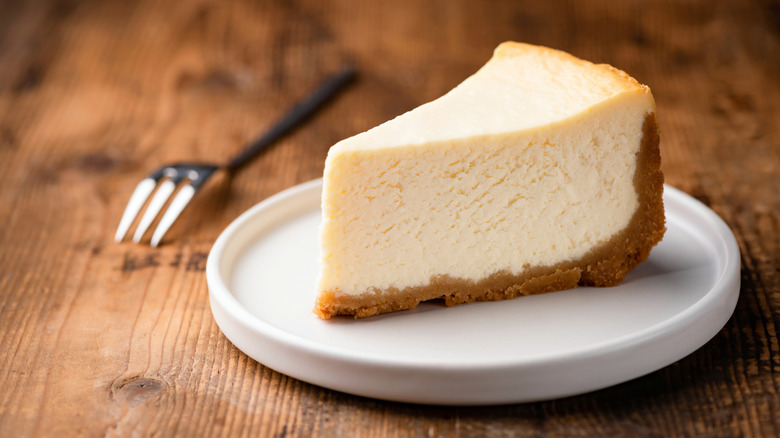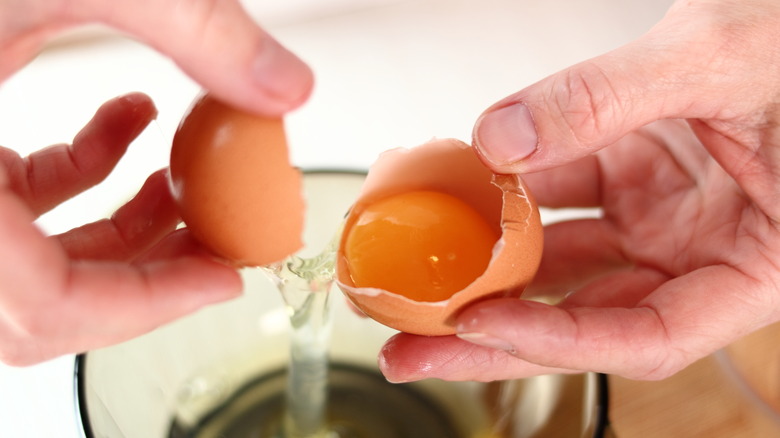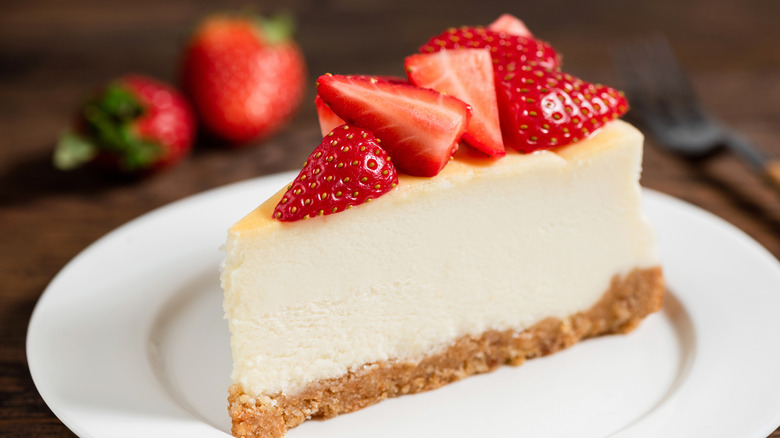What Happens If You Add Too Many Eggs To Your Cheesecake
From New York to Japanese to the sometimes-misunderstood Basque variety, cheesecake is a popular sweet ending to a meal. While The Cheesecake Factory may produce the perfect slice every time, the home baker may feel less confident sliding that springform pan into the oven. But understanding the hows and why a baking mistake happens can ensure better results.
Although there are many varieties of cheesecake, Home Stratosphere asserts that most cheesecake recipes include cheese, and eggs, egg yolks, sugar, vanilla extract, and heavy cream. Depending on the combinations of these ingredients, there are a multitude of flavors. From swapping cream cheese for a more pungent variety to adding some caramel swirls, the basic recipe can be transformed in many ways.
While there are some no-bake varieties, many recipes call for egg in the mixture, basically a version of a custard (a combination of eggs and milk or heavy cream), to be baked in an oven. But cooking with eggs can be a difficult skill to crack. Because baking is more of a science than an art, temperature, measurements, and precision will impact the final result. When the egg component is out of balance, the flavor can be unpleasant, as discussed in Ask Nigella. From tasting too eggy to a surface crack, it could be the eggs, not the cheese, that are causing the cheesecake to fail.
Cracking the egg secret for a tasty cheesecake
As Bon Appétit shares, using too many eggs when making cheesecake can cause a big divot in the middle of the dessert. Because eggs add a luscious, creamy texture to custards and cheesecakes, some bakers might be tempted to fold in another yolk or two. Unfortunately, that addition throws off the balance in the recipe, which can lead to unfavorable results, such as the "cheesecake canyon." (Similar to those fraction concepts taught in elementary math class, a sum greater than one may not be the right answer.)
Although recipes may not specify, egg size does matter in baking. According to Southern Living, large eggs are the standard in baking. While weight can be a more exact baking measurement, using a large egg is likely what the recipe creator intended, unless otherwise noted.
To ensure that your cheesecake isn't egg-spelled from the dessert table, use care when cracking those eggs into the mix, or the final result might not be egg-ceptional.
These cheesecake imperfections aren't total failures
While eggs matter to the texture and consistency of a creamy cheesecake, a few other imperfections may not spell dessert disaster. As The Kitchn discusses, a few cracks might ruin that social media picture, but it is not the end of the world when it comes to the flavor. The cracked surface can be caused by temperature fluctuations or cooling quickly. A quick fix is to top those cracks with whipped cream or fruit, or just not worrying about the little visual blip.
Still, The Spruce Eats encourages bakers to use care with each and every step in the process. From the ingredients' temperature to over-beating to not peeking in the oven, smart baking choices and techniques will help to make a better final product.
Even though it can be tempting to place an order from Junior's, mastering a delicious cheesecake in the home kitchen doesn't require Martha Stewart-level baking skills. Practice, patience, and a little diligence can help any baker rise to the occasion.


